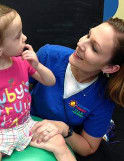

Reaching developmental milestones is an exciting part of childhood.
Every child develops in his or her own unique and beautiful way. It is perfectly normal for children to hit CDC’s developmental milestones at a slightly faster or slightly slower pace than their same age peers. And it is also common for children to have slightly advanced skills in one or two areas while lagging behind in other areas.
Small variations are perfectly typical. In addition, children are constantly growing and changing, so it is important to note continued progress and growth toward milestones rather than becoming overly concerned that a child has not achieved a single particular skill at an exact date on the calendar.
Occasionally a child’s rate of development is outside the “typical” range in such a manner that the child would benefit from some expert advice and therapeutic intervention.
Questions and concerns about your child’s development should always be discussed with your pediatrician. It is strongly encouraged that parents talk to their child’s pediatrician if they notice that their child has:
- Plateaued in an area and is not making gains toward the next milestone
- Mild delays in multiple areas
- Significant delays in a single area.
Speech and Language Developmental Milestones
The items listed below are examples of the general progression of development in young children. This guide can be used to help parents determine if a child is developing appropriately, or if professional intervention may be warranted.
- Shows interest in faces of caregivers – 3 to 4 months
- Anticipates the actions of others in games such as “peek-a-boo” – 6 months
- Babbles – 9 months
- Attempts to imitate sounds of others – 12 months
- Points to direct other’s attention to items of interest – 1 year
- Shows interest in playing with others – 1½ to 2 years
- Regularly adds new words to vocabulary and then continues to use these new words in working vocabulary – 1½ years and beyond
- Follows simple, familiar verbal directions – 1½ years
- Combines 2 words together (e.g., “my ball,” “no bath,” etc.) – 2 years
- Combines 3 words together – 3 years
- Familiar adults (teachers, parents, grandparents, etc.) can generally understand the child’s spoken speech – 2 to 3 years
- Produces all speech sounds by 8 years (Many sounds, such as “r” and “th” do not even start to emerge until around 5 years, so articulation errors are common before then.)
In addition, parents should consider a speech evaluation if the child is noticeably and routinely frustrated by a lack of communication skills at any age. Sometimes the root of behavior perceived as “naughty” is really an underlying difficulty with communication.
Feeding Developmental Milestones
In addition to speech, language, and social skills, speech therapists also address feeding issues. This can include difficulties with biting and chewing, swallowing, and being a significant “picky eater.”
The following are several developmental milestones to keep in mind as your child grows from the breast/bottle to the family dinner table:
- Synchronizes lips and swallowing to nurse from bottle/breast– at birth and beyond
- Opens mouth to anticipate food (bottle/breast) – 2 months
- Accepts purees on spoon – 5 to 6 months
- Begins to pick up food to feed self – 6 to 9 months
- Able to suck liquids from an open cup (held by an adult) – 6 to 9 months
It should be noted that speech therapists, occupational therapists, and dentists are ALL united in the fact that drinking from a sippy cup is NOT a necessary developmental milestone.
I have written about Sippy Cups in the past. Sippy cups are simply a way to keep young children from spilling drinks, but can actually cause a child to develop abnormal oral motor skills and increase tooth decay.
Other feeding milestones include:
- Gags when new food textures are introduced (any age)
- Able to chew a wide range of textures – 18 to 24 months
- Eats at least 20 different foods by 3 years
- Diet generally matches the family’s diet by 3 years
Note: Vegetables are an acquired taste, and meat is often difficult to chew for pre-school aged children. Keep introducing these foods! By continuing to place just a bite or two of meat and veggies on the plate with each meal, but not forcing the issue, your child will learn to enjoy these foods when ready. I have written about this in my Picky Eaters vs Problem Feeders Blog.
Gross Motor Developmental Milestones
- Holds head up – 4 months
- Rolls from tummy to back – 4 months
- Rolls easily in both directions – 6 months
- Sits without support – 6 to 7 months
- Crawls on hands and knees – 9 months
- Pulls to stand – 10 to 11 months
- Walks – 12 to 13 months.
- Pulls toys when walking – 18 months
- Kicks a ball – 2 years
- Begins to run – 2 years
- Jumps with 2 feet off the ground – 2½ years
- Walks up and down stairs with one foot on each step – 3 years
- Pedals a tricycle – 3 years
- Throws a ball overhanded – 4 years
- Hops on 1 foot – 4 years
- Skips with alternating feet – 5 years
Additional Questions about Gross Motor Skills
Can your child generally move his/her body (crawl, run, jump, play) in order to keep up and engage with similarly aged peers?
This is a great time for frequent trips to the park! It is it important to notice if a child generally has similar specific skills such as running and jumping, and it is also important to note if a child appears to have similar overall endurance as her peers.
Does your child trip and fall frequently? Does she bump her face/head on the ground, chair, wall, table, etc.?
This is of particular concern when the child does not reflexively put her hands out to “catch” herself.
Does your child have atypical movement patterns?
Additional items for concern that a physical therapist may watch for include: Frequent walking on tip toes, walking with toes in a pointed-in position (“pigeon-toed”), weakness on one side of the body or greatly favoring use of one side of the body.
Fine Motor Developmental Milestones
- Holds rattle placed in hands – 2 months
- Brings hands to mouth – 4 months
- Grasps and shakes rattle – 6 months
- Claps hands – 9 months
- Scribbles with marker – 14 to 16 months
- Removes a screw top cap – 2 to 2½ years
- Mimics horizontal and vertical strokes – 2 to 2½ years
- Mimics drawing a circle – 3 years
- Cuts across paper – 3 to 3½ years
- Copies a cross – 4 years
- Cuts out simple shapes – 4½ years
- Holds pencil/marker correctly – 4½ years
- Draws a person with 6 or more body parts – 5 years
Additional Questions about Fine Motor Skills
Does your toddler (birth to 3 years) use both hands fairly equally?
It is important for very young children to develop fine motor skills in both hands in order to later engage in bilateral fine motor tasks such as buttoning, using a knife and fork, or tying shoes.
Is your preschool child beginning to establish hand dominance?
Once a child starts drawing pictures and writing her ABC’s (4-5 years), it is important that one hand emerges as a preferred hand to better fine tune pencil grasp and develop the hand dexterity needed for handwriting.
Generally, when parents report that their child is “ambidextrous” (uses both hands equally well), there are actually delays in fine motor skills for both hands.
In addition, if your child is truly competent in fine motor skills for both hands, it is still important to pick a single hand for writing/cutting tasks in order for the child to begin to fine tune these complex fine motor skills.
Does your child cross midline when reaching for items?
At least by 6 months of age, you should notice your child watching and reaching for items that move from one side of her body to the other. If your child only grabs items on the left side with her left hand and only grabs items on the right side of her body with her right hand, then she won’t develop diagonal movements required for more complicated gross motor patterns.
In addition, when children rarely cross midline, they tend to also not develop handedness in a timely manner, causing the pre-academic skills such as writing and cutting to also be delayed.
Is your preschool child able to complete different actions with each hand at the same time?
As children begin to develop those pre-academic skills, watch to make sure they are able to stabilize items with their non-dominant hand while completing tasks with their dominant hand, such as holding a bottle to twist open the cap, or stabilizing the paper during coloring/writing tasks.
Social-Emotional Developmental Milestones
- Begins to smile at people/faces – 2 months
- Calms when spoken to, picked up, sucking, or looking – 4 months
- Responds to name – 6 months
- Smiles to initiate engagement with others – 6 months
- Is fearful of strangers – 7 to 9 months
- Understands “no” – 9 months
- Demonstrates “joint attention” (gives or shows by extending item to another person in order to “comment” non-verbally) – 12 months
- Pretends to feed a doll or stuffed animal – 18 months
- Imitates peers – 18 months
- Enjoys the company of other children – 2 years
- Shows defiant behavior and seeks more independence – 2 years
- Shows concern for a crying friend – 3 years
- Takes turns – 3 years
- Separates easily from parents – 3 years
- Enjoys make-believe play – 4 years
- Begins to have preferred friends – 4 years
- Wants to be like friends and make friends happy – 5 years
Additional Questions about Social-Emotional Development
Does your child generally seek out and enjoy the company of other adults and children?
Even from infancy, you should notice your child watching faces of familiar adults and siblings, and then curiously watching other children at the park, etc. As your child’s gross motor skills and social skills mature, she should seek out simple engagements with other children, developing into more cooperative and imaginative play.
Is your child able to self-soothe?
Even from infancy, children should be able to find ways to self-soothe such as sucking on their hand, or reaching for a toy. As a child grows, she should begin to be able to use words to ask others for help and gain access to what she wants (e.g., “I am hungry,” or “I want that”).
The ages of 2 to 4 years are particularly difficult times for behavior and tantrums, as children assert their independence and this is very much normal. However, when structure and consistency is provided by parents and the environment, take note if your child is unable to calm down and recover from tantrums, or if tantrums last several hours. These can be signs of difficulty with self-regulation.
Daily Living Developmental Milestones
- Removes socks – 12 months
- Finger feeds entire snack/meal – 1½ years
- Uses spoon to eat (but messy) – 1½ to 2 years
- Uses spoon and fork well – 3 years
- Drinks from open cup – 3 years
- Undresses self completely including socks/shoes – 3 years
- Dresses self with simple pull-on clothing – 3½ to 4 years
- Buttons/unbuttons simple buttons – 4½ years
- Washes and dries hands thoroughly – 5 years
Additional Questions about Daily Living Skills
Is your child consistently seeking out assistance for self-care tasks that you feel like she should be able to do by herself?
All children want the “easy way out” sometimes. And, all parents need to take the “easy way out” sometimes and just help the child with self-care tasks in order to get out the door in the morning on time!
If your child consistently refuses to perform or requests help with self-care activities, it may be important to assess if difficulties with coordination could be to blame or if behavior modification techniques may be needed to help foster independence.
If parents have significant concerns about their child’s development in a specific area, what should they do?
First, as always, parents should discuss their concerns with their child’s pediatrician. The pediatrician can help guide families to the therapist who will best evaluate and potentially treat the child if a significant deficit is in fact present. In general, physical therapists address gross motor concerns, occupational therapists address fine motor concerns, and speech therapists address speech/language concerns.
Many disciplines overlap. For example, if a child is clumsy and the parents’ primary concern is prewriting skills, the pediatric occupational therapist might address both gross motor skills as well as the fine motor and visual motor skills required for handwriting.
If a child is a severe picky eater, the occupational therapist and the speech therapist might work together to assess if the cause is more oral motor in nature (addressed by ST), or sensory/taste/smell related (addressed by OT).
If a child is having significant behavior difficulties, the OT and ST might work together again to determine if inappropriate behaviors are due to frustrations with language expression and comprehension (ST), or due to difficulties with sensory and emotional regulation skills (OT). Once again, your child’s pediatrician can help guide a child to the most appropriate pediatric therapist.
Other Medical Concerns
Yes, it is important to discuss all developmental concerns with your child’s pediatrician in order to obtain a referral to the correct therapy, but it is also important to discuss these concerns with the pediatrician to help rule out any medical causes for your concerns.
Common issues such as sleep, nutrition, mental health, poverty, and family environment should be considered. For example, it is very common for a pre-school aged child to show a plateau and possibly even a regression of developmental skills when a new little brother or sister is born, as the child’s environment has significantly changed.
This is of little concern, but should be monitored for a return to baseline and beyond as the whole family adjusts to the new baby. If it is discovered that a child has poor sleep quality in addition to delays in developmental milestones, it is important to for the physician, parents, and therapists to work together to address the sleep concerns while simultaneously addressing the delays in developmental milestones.
Finally, if you DO have concerns, don’t delay in seeking help!
It may be that the pediatrician or appropriate therapist will assess your child and be able to reassure you that your child is developing typically. If your child is, in fact, showing delays in developmental milestones, then your child’s therapy team can collaborate with you to create a plan to get your child caught up as quickly as possible. In addition, intervention is more likely to be effective when it is provided earlier in life as opposed to later.
About the author
Melissa Foster is a Nationally Board Certified Occupational  Therapist who received her Masters in Occupational Therapy from University of Central Arkansas in 2004. She came to TEAM in 2013 with a wealth of treatment experience in settings that range from NWA to Kansas to New York. Her primary interests are treatment of children on the Autism Spectrum, treatment of children with ADHD and treatment of children with sensory processing and behavioral disorders. Melissa is an active public speaker in the NWA community on topics related to Autism and Sensory Processing Disorder. She has authored several resource materials for parents on topics such as sleep and picky eating. Her blogs address topics of interest to parents and have become a popular resource for families. Melissa loves spending time with her husband and their two children. On warm summer days she enjoys sitting on her patio with a good book and a glass of iced tea.
Therapist who received her Masters in Occupational Therapy from University of Central Arkansas in 2004. She came to TEAM in 2013 with a wealth of treatment experience in settings that range from NWA to Kansas to New York. Her primary interests are treatment of children on the Autism Spectrum, treatment of children with ADHD and treatment of children with sensory processing and behavioral disorders. Melissa is an active public speaker in the NWA community on topics related to Autism and Sensory Processing Disorder. She has authored several resource materials for parents on topics such as sleep and picky eating. Her blogs address topics of interest to parents and have become a popular resource for families. Melissa loves spending time with her husband and their two children. On warm summer days she enjoys sitting on her patio with a good book and a glass of iced tea.
Resources (Accessed 2019)
American Academy of Pediatrics – Ages & Stages (downloaded April 2019)
American Physical Therapy Association: A Physical Therapist’s Guide to Developmental Delay (Downloaded April 2019)
ASHA: Feeding Infants and Toddlers
CDC’s Developmental Milestones (Downloaded April 2019)
CDC: Why Act Early if You’re Concerned bout Development (downloaded April 2019)
Children’s Therapy Team Blog: Perspectives on Sippy Cups
Children’s Therapy Team Blog: Picky Eaters vs. Problem Feeders
Evidenced-Based Milestone ages as a framework for developmental surveillance. Pediatric Child Health. Dec 2012.
Peabody Motor Development Chart. M. Rhonda Folio & Rebecca R. Fewell. (2002)
